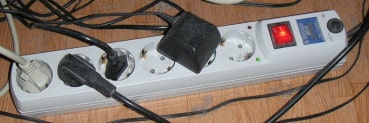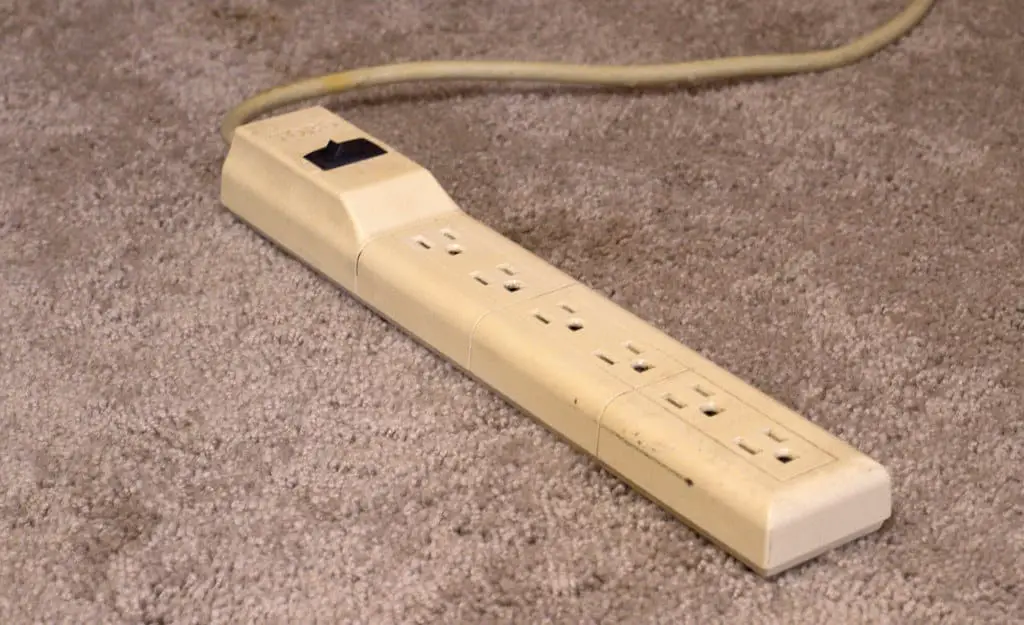I have always been a DIY guy and keen on trying to maximise the output efficiency of almost all the smart devices that I have either built at home or bought off-the-shelf and fitted for my use. My keen interest into settings things up my way is what drives my interest to specific topics, and in this one, I cover up a great technique that can help you use either your smart plug into a surge protector and the opposite.
So the question at hand is, can one plug a smart plug directly into a surge protector? The plain and a straightforward answer is “YES” you can! Happy now? But don’t just get carried away after reading this one-worded response. There are some constraints to what derived me to say “yes” in this scenario. So buckle up and read through the rest of the article to find out how safely you can do it and what are the benefits and cons of connecting your smart plug into a surge protector that may have been lying around your home. After all, we are the Smart Nutter’s! Aren’t we lads.
If you need to connect your smart plug directly into the traditional surge protectors, then always make sure you do not exceed the wattage limitations present on the surge protector board itself. Under no circumstances should you be connecting the smart plug into the surge protector if the device that gets connected to the smart plug alternatively exceeds the wattage specifications of the surge protector.
You may ask, what is a surge protector? A surge protector is a strip that protects your electrical devices from surges that can occur due to high or low voltage zits and can often damage the equipment that is connected to these boards. A surge protector protects this equipment by ensuring the cut off the power supply naturally without harming the components connected on it via the outlets present on the strip.
What is a smart plug? A smart plug is generically a plug that can connect itself to a Wi-Fi connection at your home, and thus allowing the owner of the plug to toggle itself on and off via an app on the smartphone.
Since we have that out of the way. Let us now focus on the topic at hand
Table of Contents
Can a Smart Plug Be Connected to a Surge Protector
Realistically, the smart plugs are enormous in shape and do not tend to go well on surge protectors as most of the geometrical shape that a smart plug has, tends to cover up the outlets present on your surge protector strip. Almost all of the times if you require to plug one smart plug into a surge protector then you are better off connecting that smart plug directly onto the wall socket. This is greater of a utility, and thus you can use the power strip for the other electrical components that you don’t wish to be connected via a smart plug.
But if you are like me and this question in debate is still stuck in your mind, then read the below tips carefully before you attempt to connect your smart plug into the surge protector strip.
For this very example, we would be taking into account the surge protector strip that is readily available on Amazon. Namely: AmazonBasics 6-Outlet with Surge Protection Power strip.
The breakdown of the AmazonBasics Surge Protector Power Strip is as under
| 14 Gauge System | 200 Joule With three (3) line Basic Surge-Protection (Capable to protect small electronic appliances such as – phones and lamps) |
| 15-A circuit breaker | 2 Foot in length and has a 14 AWG cord |
| 125V | 60 Hz, with Max output efficiency of 1875W |
Keep into account the maximum wattage of 1875W on this particular make.
Get hold of a smart plug and connect it to one of the outlets on the power
strip. Grab your favourite electronic appliance, (I took a toaster for this
test), and connect it to the power strip. Since the max wattage on my toaster
was 800W, I was still well within the limits of the total wattage the surge
protector could handle. Given this scenario, I was successfully able to control
my smart plug using my smartphone, and without the worry of if I’d be burning
down my house, God forbid!
Let us now approach this concept from a different angle!
Can a Surge Protector be plugged to a Smart Plug at your home

As hard and as difficult as it may sound, but the answer is “YES”. You can very well connect a surge protector strip directly onto the outlet of your smart plug. But what is the catch here? I would give you a “cake” if you guessed it right!
As long as the total power of the appliances connected onto your surge protector strip does not exceed the total wattage of the smart plug, you are free to link your power strip to your smart plug.
Now, why would you want to do this?
Maybe you want all the appliances you have connected onto that particular surge
protector of yours to be controlled via the smart plug, in one shot. Perhaps
you want the switch on or off those devices in one-go whenever you want. Who
knows, I am here to prove the concepts on this question at hand and have taken
the liberty to exercise each step before penning it down.
At best, you should seek guidance from an authorised and a qualified electrician too before you attempt doing this. The second thing you must do before trying this out at home is to read up on the product specification page of your particular smart plug. If that is not available, then do not just ignore this step and start on with the exercise of trying it out. Instead, go to the website of the manufacturer and get hold of that manual and find out about the total wattage specifications on your particular plug.
For this particular experiment, I choose to use a smart plug that I had bought off Amazon. The product is the TP-LINK HS110 Smart Plug w/Energy Monitoring. At the time of its purchase, it cost me approx. 20USD. Prices may change on this particular product if you are that eager to buy this particular one. But it has worked great for me, so you might give it a try. Interested to know more about this product, then click here
Supported load types on this particular product are as of follows
| Coffee Maker | 800 W |
| Desk Lamp | 235.2 W |
| LCD | 270 W |
| Heater | 1500 W |
| Humidifier | 260 W |
| Iron | 1500 W |
| Toaster | 850 W |
| Tower Fan | 50 W |
No, do not interpret this table in your own way. By sharing these figures, I do not mean at all that you can connect all these devices onto your power strip and then hook them up to the “poor” TP-LINK HS110 smart plug. You will not only fry the plug instead pose a severe threat to your well-being.
The reason for sharing this chart is so that the maximum load this particular smart plug can handle is 1,500 Watts. Which in my case was the “iron”?
So we can safely assume, that once you connect your complete appliances onto the surge protector and plan to connect the power strip to your smart plug, the total value of the WATTS attached on the surge protector shouldn’t exceed that maximum input value of 1,500 WATTS. PERIOD!
Further breakdown on the product specification of TP-Link HS110 smart plug is
| Item Weight | 5.3 ounces |
| Product Dimensions | 2.6 x 2.5 x 3.9 (inches) |
| Voltage | 120 volts |
| Max Wattage | 1500W |
| Warranty | 2 Years |
So if you planned to connect your power strip with 5 heaters and then pop it into the smart plug so you may control the switching off and switching on, of those heaters; then you, my friend – are a unicorn!
Are There Smart Surge Protectors Available In The Market?
You guessed it right. Yes, there are smart surge protectors and
power strip available to us. Thanks to the advancement in technology and how
the adoption of these smart products is widely accepted.
What
is the prime difference between smart surge protectors a standard power strip
Smart surge protectors can be controlled over the internet
via a smart-app, so you can easily set schedules when to cut off the power in
an automated way. Along with it, if there is a power surge; the strip is
capable of cutting the power off automatically and mitigates the damage the wave
could have caused to the electric appliances connected on it.
While a standard power strip just provides you with the flexibility to connect
multiple devices onto the strip without the benefits of having surge protection
in place.
Thanks to smart voice assistants and smart hubs, these smart surge protectors can now be synced easily with them, thus giving you the option to control them via the voice commands. As I am a staunch believer of technology and its incorporation and benefits that it brings in our lives’, it is safe to assume that one should have at least “one” smart surge protector at their home’s to see what kind of benefits it brings into their life’s.
The bandwidth requirement of smart strips or smart surge protectors is close to none. More info is available here in the article that I have written for your ease
Most of the smart surge protectors have features such as
- Wi-Fi capability
- Energy monitoring
- Dedicated USB ports for charging
- Surge protection – Duh!
- Scheduler
- Voice Control
With the invent of IFTTT and its full acceptance by major manufacturers around the globe, it won’t be long when these devices would be IFTTT compatible and then you may quickly go through the learning curve of incorporating the modifications IFTTT concept brings on the table.
Now a million-dollar point. Until recently, I have noticed few surge protectors are labelled to pair well with your smart plugs. Well, I would still keep all the points in this article at hand before you start connecting all your devices onto one surge protector and popping them onto the smart plug. It is bound to go wrong one way or another. So better be safe than sorry!
Some frequently asked questions that I usually get from my peers are
How do the surge protectors function?
If there ever is a power spike or low voltage, on the other hand, then a surge protector would be able to handle such a scenario. While on the other hand, a traditional power strip would cause your connected devices to either fry out or be severely damaged. A surge protector suppresses that power spike and cuts off the current supply to the appliances connected to it. Power spikes usually happen when there is either massive rain, a circuit breaks and very occasionally during a direct lightning strike.
Power strips, on the other hand, are just duds. They are there to extend the portability and provide you with an option to connect multiple devices onto it. Most people use regular power strips to connect various devices on a single wall-plate. But in all honesty, you are wise off connecting your “expensive” (the stress is on the term expensive here) to a smart plug rather than comparing it to a power strip which has no surge protection. That 15 dollar toaster can very well go directly into a power strip rather than an expensive smart plug or a surge protector.
Are smart plugs cheap to buy?
There is no hard and fast answer to this particular question. But in the essence of the subject and the website SmartNutter.com; I am here to guide you through the gadgets, tricks, tips and techniques those can assist you to convert your traditional home into a smart home without a lot of fuss and burning a hole in your pocket. So given that, there are certainly some smart plugs that cost hundreds of dollars. But you do not need those. To get the basic work done and remain safe and secure, a smart plug’s only benefit is that it gets controlled remotely and you can shut off or switch on the current in it by the flick of a switch on your smartphone. This shouldn’t be that expensive you may say? Well, some smart plugs are available in the market in between the price range of $20 to $50. Within this price range, you should be able to get hold of a smart plug that is best suited to your needs and is industrial certified and compliant for safety.
What is the price difference in between a surge protector and a power strip?
We all know by now the benefits of hooking up your expensive
electrical devices to a surge protector. But if you are still persistent to
know if a surge protector would break your bank, then you are in for good news.
A traditional power strip shouldn’t cost you more than $10. And if you are a
brand-conscious-geek; then at high retailers these products shouldn’t cost you
more than 25$.
So is the case with these surge protectors. A decent surge protector with
safety standards and regulations should cost you anything between $25 to $35.
You can easily bag a deal on these surge protectors if you are signed up to
your local community newsletters. This way you can very easily come to know
when the sale is on, and it would then just be a matter of hopping onto your
car and going to the market to get this bad boy home!
How do I identify which particular power strip is a surge protector, and which is regular?
A great question if I may say! Most of these surge protectors and power strip boards look identical. But there is a cue here. A surge protector would either have a big label affixed on the cover of the device itself, or it may also come with a different name such as “surge suppressor”. If you are still confused, then tilt the packaging and see if you can find out the word “JOULES” present. If you can find the word joules it means you are holding the surge protector. Voila! This is because surge protectors measure their energy coefficient in “joules”, which is present in the energy rating of the packaging present on it.
You should also be able to find out the total amount of
voltage this surge protector can handle in case of a power spike. So now, you
have 2 ways to identify if the strip that you are holding in the market is a
power strip or a surge protection strip.
Do not go trotting away into your patio and start picking up those old power
strips, just to see if you have got any surge protectors at your home or not!
Safe “jetsons” home!


